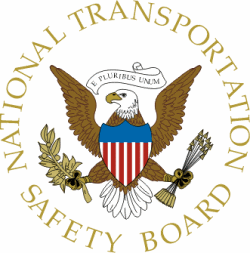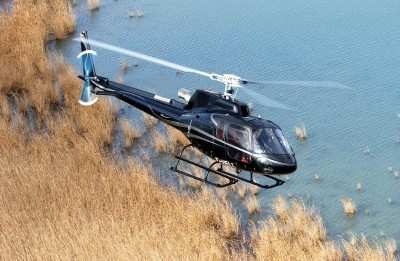Pilot Continued VFR Into IFR Conditions, Report Says
The NTSB has released its probable cause report from a medical
helicopter accident which occurred in Georgtown, SC in 2009. The
report is pretty straight forward, indicating that the pilot
continued VFR flight into IFR conditions. The result was,
unfortunately, one that is far too common in such instances.

NTSB Identification: ERA09FA537
14 CFR Part 91: General Aviation
Accident occurred Friday, September 25, 2009 in Georgetown,
SC
Probable Cause Approval Date: 01/19/2012
Aircraft: EUROCOPTER AS-350, registration: N417AE
Injuries: 3 Fatal.
After conducting an interfacility patient transfer, the pilot
refueled and then requested flight-following services from air
traffic control, departing in visual meteorological conditions
(VMC) for the return flight to his base. During the return flight,
the pilot encountered instrument meteorological conditions (IMC). A
review of Sky Connect data for the accident flight revealed that
the helicopter was cruising at varying altitudes and never reached
a steady state cruise altitude for any significant period of time.
The majority of the flight was flown at altitudes below 1,000 feet
with the greater part of the last 8-minute segment of the flight
being operated below 800 feet. (The lowest altitude recorded during
the last cruise segment of flight was 627 feet.) Witnesses who
observed the helicopter before the accident described it as flying
about 1,000 feet above ground level (agl), with its searchlight
turning on and off, in moderate to heavy rain. A subsequent loss of
control occurred, and the helicopter impacted terrain about 1.92
nautical miles (nm) southwest of Georgetown County Airport
(GGE).
Postaccident examination of the main wreckage revealed no
evidence of any preimpact failures or malfunctions of the engine,
drive train, main rotor, tail rotor, or structure of the
helicopter. Additionally, there was no indication of an in-flight
fire.
During the first legs of his flight, the pilot experienced and
observed VMC conditions along his route. However, postaccident
witness reports and in-flight statements from the accident pilot
indicated that the weather in the area had deteriorated since his
southbound flight 2 hours prior. According to Omniflight’s
Savannah, Georgia, base manager, who was also a pilot operating in
the area on the night of the accident, the weather that night was
deteriorating but was forecast to remain well above minimums for
his flight from Savannah to Greenville, South Carolina, and then to
the Medical University of South Carolina (MUSC) in Charleston.
However, while he was refueling at the Greenville airport, the
pilot of the accident helicopter contacted him by radio and advised
him to double check the weather before returning to MUSC. The
accident pilot stated that “bad thunderstorms” were in
the GGE area and that he did not know if he would be able to return
to his base that night. The Savannah base manager then advised the
accident pilot that he could stay at the Charleston base that
night. However, the accident pilot decided to return to his base at
Conway-Horry County Airport (HYW), Conway, South Carolina.
Review of radar data and weather observations provided by the
National Oceanic and Atmospheric Administration revealed that,
after departing, the helicopter entered an area of convective
activity and precipitation. The University Corporation for
Atmospheric Research regional radar mosaic chart for 2333 also
depicted a large area of echoes north of the frontal boundary, with
several defined thunderstorms and rain showers extended over South
Carolina and over the accident helicopter’s flight route.
Additionally, correlation of the radar data to the location of the
accident site revealed that several defined cells surrounded the
site at the time of the accident.
The terminal aerodrome forecast (TAF) for Myrtle Beach
International Airport, Myrtle Beach, South Carolina, which was
located 29 nm northeast of the accident site, was issued about 1928
and indicated expected marginal visual flight rules conditions
through 0100 on September 26. From 2000 through 2130, variable
winds to 15 knots with visibility of 4 miles in thunderstorms,
moderate rain, and a broken ceiling of 3,500 feet agl in
cumulonimbus clouds were expected. From 2130 to 0100, the wind was
expected to be from 040 degrees at 12 knots with a visibility of 6
miles in light rain showers and mist and a broken ceiling at 2,000
feet agl. About 2207, the National Weather Service issued an
amended TAF that expected instrument flight rules (IFR) conditions
to prevail during the period with a broken ceiling at 700 feet agl
and light drizzle and mist after midnight.
AS-350 File Photo

The pilot had previously flown helicopters in IMC but was not
current in instrument ratings at the time of the accident. The
accident helicopter was not certificated for flight in IMC but had
sufficient instrumentation to operate in the event of an
inadvertent encounter with IMC. On the pilot’s last Part 135
airman competency/proficiency check, which occurred on December 12,
2008, he satisfactorily demonstrated inadvertent IMC loss of
control recovery.
Although the pilot encountered an area of deteriorating weather
and IMC, this did not have to occur as the pilot did not have to
enter the weather and could have returned to Charleston Air Force
Base/International Airport or landed at an alternate location. The
pilot, however, chose to enter the area of weather, despite the
availability of safer options. Based on the pilot’s statement
to the Savannah-based pilot regarding bad thunderstorms in the
area, he was aware of the weather and still chose to fly into it.
In addition, the pilot’s inability to maintain a steady state
cruise altitude during the flight and the declining altitude
throughout the flight likely reflected his attempt to stay below
the cloud level. These cues should have indicated to the pilot that
it was not safe to continue flight into IMC. This decision-making
error played an important causal role in this accident.
In the absence of evidence indicating a mechanical malfunction,
severe turbulence, or some other factor that would explain the
accident pilot’s apparent loss of control of the helicopter,
spatial disorientation is a likely explanation, as it has
contributed to many accidents involving loss of control. In many
cases, loss of control follows a pilot’s inappropriate
control inputs resulting from confusion about the aircraft’s
attitude. Two major situational risk factors for spatial
disorientation were present in this accident, including high
workload and transitions between VMC and IMC that require shifting
visual attention between external visual references and cockpit
flight instruments. Attempts to continue visual flight into IMC are
even more problematic for helicopter pilots than for pilots of
fixed-wing aircraft because helicopters are inherently less stable
and require near-continuous control inputs from the pilot.
Helicopters, like the accident helicopter, that are not equipped
for IFR flight and do not have control stabilization or an
autopilot impose high perceptual and motor demands on the pilot.
This can make it very challenging for pilots to maintain stable
flight by referring to flight instruments alone. When the accident
pilot attempted to continue visual flight into IMC, he would have
been subjected to a high workload to maintain control of the
helicopter. The extent of the weather and the duration of the
flight also suggest that the pilot’s encounter with IMC was
prolonged. This would have further complicated the pilot’s
workload and increased the potential for spatial disorientation
resulting from hazardous illusions, thereby increasing the
potential for inappropriate control input responses.
According to Omniflight’s 135 Operations Manual, the
pilot-in-command was responsible for obtaining weather information
before beginning a series of flights. During interviews with
National Transportation Safety Board (NTSB) investigators,
Omniflight pilots indicated that, at the beginning of each shift,
they would obtain weather information from a base computer and
would advise the Omniflight Operational Control Center (OCC) of
weather conditions in the operating area throughout the period of
their flight. Before any launch, the OCC must approve the flight.
If the OCC knew of adverse weather, it would contact the pilot to
evaluate the weather. Based on launch approval and actual weather
conditions encountered and reported by the pilot, the weather at
takeoff and along the flight route was VMC. About 2242, an MUSC
communications center specialist spoke with an Omniflight OCC
operations coordinator and indicated that the helicopter would be
returning to HYW as soon as the patient transfer was complete. The
operations coordinator then advised the MUSC specialist that if the
pilot called before takeoff, they would review the weather with him
for his return flight. However, the pilot never called the OCC, and
the OCC did not contact the pilot. While the OCC was not required
to contact the pilot and review the weather, if the OCC had
contacted the pilot before takeoff, the OCC could have advised the
pilot about the adverse weather, given him the updated TAF
information issued about 2207 with IMC, and noted the potential
risks involved with the flight. On February 7, 2006, the NTSB
issued Safety Recommendation A-06-14, which asked the Federal
Aviation Administration (FAA) to “require emergency medical
services operators to use formalized dispatch and flight-following
procedures that include up-to-date weather information and
assistance in flight risk assessment decisions.” On February
18, 2010, based on the FAA’s pending notice of proposed
rulemaking concerning helicopter operations and pending timely
issuance of a final rule mandating formalized dispatch and
flight-following procedures that include up-to-date weather
information and assistance in flight risk assessment decisions, the
NTSB classified this recommendation “Open—Acceptable
Response.”
The accident helicopter was not equipped with an autopilot. On
September 24, 2009, the NTSB issued Safety Recommendation A-09-96,
which asked the FAA to “require helicopters that are used in
emergency medical services transportation to be equipped with
autopilots and that the pilots be trained to use the autopilot if a
second pilot is not available.” On December 23, 2009, the FAA
stated that it would conduct a study of the feasibility and safety
consequences of requiring a second pilot or operable autopilot. On
October 7, 2010, pending the NTSB’s review of the results of
this study, Safety Recommendation A-09-96 was classified
“Open—Acceptable Response.”
The National Transportation Safety Board determines the probable
cause(s) of this accident as follows:
The pilot’s decision to continue the visual flight rules
flight into an area of instrument meteorological conditions, which
resulted in the pilot’s spatial disorientation and a loss of
control of the helicopter. Contributing to the accident was the
inadequate oversight of the flight by Omniflight’s
Operational Control Center.
 ANN's Daily Aero-Linx (05.06.25)
ANN's Daily Aero-Linx (05.06.25) ANN's Daily Aero-Term (05.06.25): Ultrahigh Frequency (UHF)
ANN's Daily Aero-Term (05.06.25): Ultrahigh Frequency (UHF) ANN FAQ: Q&A 101
ANN FAQ: Q&A 101 Classic Aero-TV: Virtual Reality Painting--PPG Leverages Technology for Training
Classic Aero-TV: Virtual Reality Painting--PPG Leverages Technology for Training Airborne 05.02.25: Joby Crewed Milestone, Diamond Club, Canadian Pilot Insurance
Airborne 05.02.25: Joby Crewed Milestone, Diamond Club, Canadian Pilot Insurance




